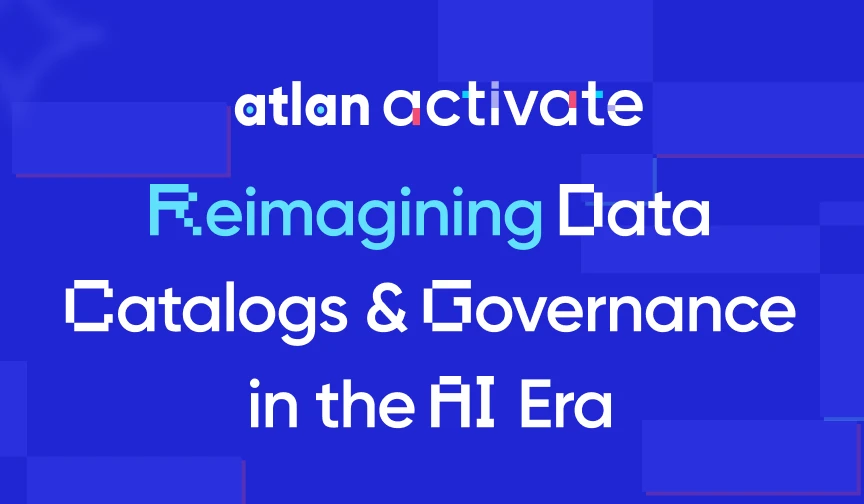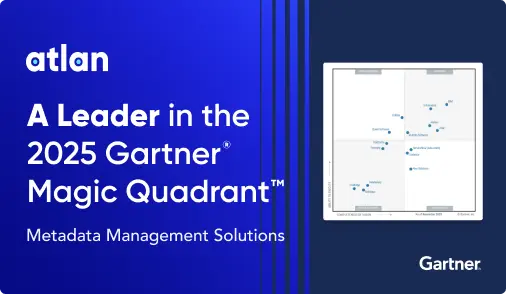Data Migration in Fintech: Your Complete 2025 Guide
Share this article
Data migration in fintech is a strategic transition that enhances operational efficiency, strengthens compliance, and enables AI-driven innovation. Fintech firms migrate their data whenever they’re expanding their portfolios, integrating new technologies, or undergoing mergers and acquisitions.
See How Atlan Simplifies Data Governance – Start Product Tour
This article explores the nuances of data migration in fintech, its business benefits, challenges, and the role of a unified control plane in modernizing the data stack.
Table of Contents
Permalink to “Table of Contents”- What is data migration in fintech?
- Business benefits of data migration in fintech
- Top challenges of data migration in fintech
- Data migration in fintech: How a unified control plane can act as a consistent layer of oversight
- Data migration in fintech: Essential capabilities
- Summing up
- Data migration in fintech: Related reads
What is data migration in fintech?
Permalink to “What is data migration in fintech?”Data migration in fintech is the process of transferring data from one system or storage environment to another. Whether moving from on-premise infrastructure to the cloud or consolidating disparate systems, fintech companies rely on data migration to integrate a fragmented data landscape, streamline operations, enable real-time decision-making, and enhance regulatory readiness.
According to Gartner, successfully migrating to the cloud means delivering maximum benefits with minimal effort and costs. It is “the key to the kind of purposeful digitalization businesses need to offset rising costs and outmaneuver any recession.”
Business benefits of data migration in fintech
Permalink to “Business benefits of data migration in fintech”“ Mastering the process of migrating data enables financial organizations to securely deploy services and better understand the behavior of their customers. [This] can streamline processes, increase ROI and contribute to a better end-user experience.“ - Forbes
Migrating to modern data platforms allows fintech companies to enhance performance, security, and compliance while preparing for future innovations. Key benefits include:
- Operational efficiency: Moving to a modern data architecture supports automation, streamlining data governance, reducing manual intervention, and enhancing scalability.
- Enhanced customer experience: Unifying customer data across channels enables fintechs to deliver seamless, personalized services and better financial insights. It also promotes cross-team collaboration across regions.
- Regulatory readiness: As new regulations like DORA, CCPA, and GDPR take effect, modernizing the data ecosystem can ensure compliance to data privacy laws, facilitate audit readiness, and minimize legal risks.
- Interoperability: Migrating to an open, API-friendly infrastructure ensures seamless data flow between fintech platforms, ensuring updated metadata (in real-time), enhancing service delivery, and improving compliance tracking.
- AI readiness: AI-powered risk assessment, fraud detection, and credit scoring models require clean, structured, and well-governed data. Migrating data to modern platforms enables fintech firms to maintain AI-ready data, which improves the accuracy of ML model training and deployment.
- Better security and resilience: Migrating to modern cloud infrastructure minimizes the risk of breaches and data loss, ensuring business continuity.
Top challenges of data migration in fintech
Permalink to “Top challenges of data migration in fintech”Whether shifting to cloud platforms, consolidating data systems, or upgrading legacy architecture, fintech companies migrating their data infrastructure face a range of technical, operational, and regulatory hurdles. These include:
- Data complexity and fragmentation: Fintech firms handle vast, high-velocity data from payment gateways, risk models, and customer transactions.Inconsistent data formats and governance practices, coupled with data fragmented across multiple sources make migration more complex.
- Legacy system transitions: Outdated infrastructure, rigid data formats, and batch processing architectures make it difficult to migrate data. Extracting, transforming, and loading (ETL) data from legacy systems requires overcoming format mismatches, rigid architectures, etc. to avoid data loss, corruption, and integration failures.
- Data quality and integrity requirements: Poor data quality—such as duplicate transactions, incomplete customer records, or inconsistent metadata—can lead to incorrect financial reporting, customer disputes, and regulatory non-compliance.
- Downtime risks: Real-time transaction processing is a core requirement for fintech platforms, from mobile banking apps to trading systems. Migration downtime can disrupt transaction processing, lead to payment failures, and impact business continuity.
- Regulatory compliance challenges: Data migration introduces potential vulnerabilities, including unauthorized access risks, encryption gaps, and misconfigured security controls. Additionally, regulators require organizations to maintain detailed audit trails of how data is handled during migration, increasing the complexity of the process.
- Vendor lock-in: Vendor lock-in restricts adaptability, making it difficult to integrate with emerging technologies or comply with regulatory changes. To avoid this, organizations should prioritize open standards, API-driven architectures, and interoperability with third-party services
Data migration in fintech: How a unified control plane can act as a consistent layer of oversight
Permalink to “Data migration in fintech: How a unified control plane can act as a consistent layer of oversight”As mentioned earlier, fintech companies manage massive volumes of data across payment platforms, fraud detection systems, credit risk engines, and more. Migrating these disparate data sources requires a unified control plane to ensure seamless oversight.
A unified control plane acts as a gateway to understanding and applying data across platforms. It can align compliance, security, and lineage tracking across fintech operations by embedding governance within every workflow. It empowers diverse end users, such as financial analysts or compliance officers, to access the data they need for their roles.
For instance, fintech companies migrating from legacy to modern platforms can use a unified control plane to identify assets being migrated, as well as to map the downstream objects affected by decommissioning in the legacy platform.
It also enables AI-powered insights that can support risk modeling, underwriting, fraud detection, and other fintech use cases.
For example, AI-driven risk analysis can detect fraudulent transactions in real time. By integrating machine learning models with the payment processing infrastructure, you can evaluate transaction patterns, user behavior, and metadata to flag potential fraud before it impacts merchants.
A unified control plane ensures that these AI models have access to clean, well-governed data across various sources—ensuring accuracy, compliance, and scalability while enhancing fraud prevention capabilities.
Data migration in fintech: Essential capabilities
Permalink to “Data migration in fintech: Essential capabilities”The key capabilities of a unified control plane that can simplify data migration in fintech include (but aren’t limited to):
- Active metadata management: Collect and manage metadata from all data sources via their metadata layer. This includes CRMs, banking apps, payment systems, and more. Also, enable two-way communication between the metadata layer and control plane, ensuring that all data ecosystem components stay synchronized.
- Unified data governance: Govern all data assets from a central place where all the metadata is stored, classified, and managed. Use a centralized policy manager and transparency center to get a real-time view of policy coverage, incidents, and breaches.
- Automated data lineage: Leverage cross-system, column-level data lineage built on active metadata to track data transformations across platforms.
- Real-time compliance monitoring: Monitor real-time changes to metadata and automate policy updates to maintain regulatory adherence. Also, set up automated audit trails and access logs to ensure regulatory compliance.
- Intelligent automation: Use intelligent automation for data ownership, asset certification, tag propagation, pipeline alerts, and more. Set up automated workflows in response to changes in metadata, reducing manual intervention and improving operational efficiency.
How Nasdaq modernized their data stack with Atlan
Permalink to “How Nasdaq modernized their data stack with Atlan”Nasdaq is the world’s second largest exchange and home to the world’s most prestigious technology companies, with $18 trillion in market capitalization. It operates over 30 exchanges across a variety of asset classes across the globe.
Nasdaq grappled with data complexity and legacy systems. Trading system data is challenging in size, and in complexity, with as many as 140 billion events per day processed in just the United States. As the data types grew and the demand for data increased, Nasdaq’s legacy tools couldn’t keep up.
So, Nasdaq took a step back to re-evaluate its data stack and modernize it by investing in modern platforms like dbt, AWS (Redshift, Glue, QuickSight), Monte Carlo, and Atlan.
Nasdaq adopted Atlan as their window to modernizing the data stack, and as a vessel for a data governance practice that was quickly maturing. Without a platform like Atlan, data and capabilities would remain undiscoverable, reducing the potential ROI.
“The one comment that keeps coming up is ‘This is like having Google for our data’.” - Michael Weiss, Product Manager at Nasdaq
With Atlan, Nasdaq reduced time spent on data discovery by a third, catalyzing a common understanding of their data and the tools at their disposal.
Summing up
Permalink to “Summing up”Data migration in fintech modernizes infrastructure, unlocks AI-driven insights, and improves compliance posture.
By leveraging intelligent automation, cloud-native architectures, and a unified control plane, fintech firms can seamlessly transition to next-gen platforms while minimizing risks. As a result, fintech firms can unlock new business opportunities to scale, innovate, and deliver seamless financial experiences.
Data migration in fintech: Related reads
Permalink to “Data migration in fintech: Related reads”- Benefits of Moving from On-Premise to Cloud
- Data Migration: On-Premise to Cloud - 10 Steps to Success
- 8 Essential Strategies to Fast-Track Your Cloud Migration Journey
- Cloud vs On-Premise vs Hybrid: Choosing the Right Data Management Approach
- Data Migration in Banking: A Complete Guide
- What is Data Governance? Its Importance, Principles & How to Get Started?
- Data Governance and Compliance: An Act of Checks & Balances
- Data Governance and GDPR: A Comprehensive Guide to Achieving Regulatory Compliance
- Role of Data Catalog in Data Security: Why It Matters
- Data Compliance Management in 2025
- Financial Data Governance: Strategies, Trends, Best Practices
- Data Governance Policy: Examples, Templates & How to Write One
- Automated Data Governance: How Does It Help You Manage Access, Security & More at Scale?
Share this article





















